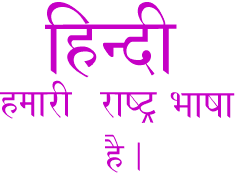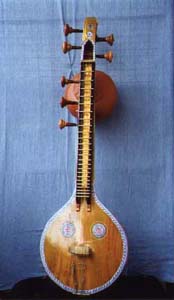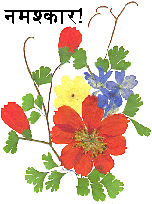| Table of contents |
| Geographical Position |
| Demographic Profile |
| Constitution |
| Climate |
| National Emblem |
| Indian Flag |
| National Song |
| National Flower |
| National Tree |
| National Fruit |
| National Calender |
| National Animal |
| National Bird |
| Currency |
| National Anthem |
| National Language |
| National Sports |
| Indian Culture |
|
Indian History in Comics |
| Visit India |
| Discussion board |
| Indian Festivals |

|
World Time
 Click here. Click here.
|
Current World Time
Indian standard time (IST) is equal to Greenwich Mean time (GMT) + 5 ˝ hours.
|

National Language
|
Official Language is Hindi
|

|
|
The national language of the country is Hindi. The country has 25 States 6 Union territories and a national capital Delhi. Different languages are spoken in all the
states. For the convenience of the people of India , the constitution had allowed English to be the National language for ten years , but the time has since then been extended. The
usage of Hindi has increased many folds in the Government Offices these days all over India .
|

The National Anthem

The song Jana Gana Mana, composed by Rabindranath Tagore, was adopted by the Constituent Assembly as the National Anthem of lndia on 24 January 1950. It was first sung on 27 December 1911 at
the Calcutta session of the Indian National Congress. The complete song consists of five stanzas. First stanza consists full version of the national anthem. It reads:
| National anthem
Jana-gana-mana-adhinayaka, jaya he
Bharata-bhagya-vidhata
Punjab-Sindhu-Gujarata-Maratha-
Dravida-Utkala-Banga
Vindhya-Himachala-Yamuna-Ganga
Uchchala-Jaladhi-taranga
Tava shubha name jage
Tava shubha ashish maange
Gahe tava jaya-gatha
Jana-gana-mangala-dayaka jaya he
Bharata-bhagya-vidhata
Jaya he, jaya he, jaya he
Jaya jaya jaya, jaya he !
|
Meaning
Thou art the rulers of the minds of all people,
dispenser of India's destiny.
Thy name rouses the hearts of Punjab, Sind, Gujarat and Maratha, Of the Dravida and Orissa and Bengal;
It echoes in the hills of the Vindhyas and Himalayas, mingles in the music of Yamuna and Ganga and is chanted by the waves of the Indian Sea.
They pray for thy blessings and sing thy praise.
The saving of all people waits in thy hand,
thou dispenser of India's destiny,
Victory, victory, victory to thee.
|
Playing time of the full version of the National Anthem is approximately 52 seconds. A short version consisting of first and last lines of the stanza (playing time approx. 20 seconds) is also
played on certain occasions.The English Stanza was rendered by Tagore.

Indian Culture
Culture

|
Culture the world over is a result of give and take between various peoples. While India has contributed to the enrichment of culture it has also drawn from the efforts of people in other parts of the world with -whom it came in contact.
"It is already becoming clearer that a chapter which has a western beginning will have to have an Indian ending if it is not to end in the self-destruction of the human race... At this supremely dangerous moment in history
the only way of salvation for mankind is the Indian Way. "
- Dr. Arnold Toynbee
British Historian 1889-1975
|

Places to Visit
Click below to see some of the beautiful places of India
 |
India has a rich history and the palaces, temples and great cities of its ancient cultures cannot fail to
grip the imagination. In the spring particularly, the big cities come alive with concerts, plays, parties
and exhibitions. Among the most spectacular hill stations (mountain resorts which make ideal destinations in summer) are Shimla (once the Imperial summer capital), Mussoorie, Ranikhet and Nainital (within reach of Delhi), and West
Bengal's magnificent resort, Darjeeling, which offers a breathtaking view of the whole Kanchenjunga range. Along the fabled coasts of Malabar and Coromandel, unspoiled sandy beaches stretch for miles. Skiing is possible in the
silent snowbound heights of Gulmarg and Kufri in the Himalayas.
|

Climate of India
  

Click here for weather in different cities of India
|
Tropical monsoon type with winter (Jan-Feb), summer (Mar-May), south-west monsoon season (Jun-Sep) and
post-monsoon or north-east monsoon season (Oct-Dec). Most of the rainfall is brought by the south-west monsoon. Because of the geographical diversity of India, regional climate conditions in the extreme north, east and west varies from the general conditions given above.
|

Festivals of India
Click Below

Government of India Tourist Office (GTI)
88 Janpath, New Delhi 110 001, India .
Tel: (11) 332 0005 or 332 0008 or 332 0109 or 332 0266.
Fax: (11) 332 0332.
|
There are hundreds of festivals and fairs which are of regional significance, celebrated with equal pomp and colour. The most authentic of these are the following: The Temple Festivals in southern India, a list of which is
often available at GITOs. Festivals at Ladakh in Kashmir. Festivals in Rajasthan; a visitor will be unlucky to visit Rajasthan at a time when a festival of some kind is not either in progress or about to take place. The visitor may also be lucky enough to witness dancing at a village festival or a private wedding. (b) March 1999-2000 has been declared the Khajuraho Millennium Year by the Indian government and the state of Madhya Pradesh in celebration of the ancient site of Khajuraho (built 900-1100 AD). In celebration of the 20 remaining temples from the 1000-year-old dynasty and in order to make visitors aware of India's cultural and religious heritage, a number of special Khajuraho
millennium events will be held throughout the country. These include educational workshops, dances, theatre, a film festival, music and artistic workshops. For a full list contact the Government of India Tourist Office . |

Indian Dance
|
The origin of classical dance in India goes back to atlest 2BC when the ancient treatise on dance, Natya Shastra, was compiled. Dance in India is guided by the elaborate
codes in the Natya Shastra and by mythology, legend and classical literature. Both classical and fold form of dances are performed in India. Classical dance forms have
rigid rules for presentation. Among the leading forms of classical dance are Bharat Natyam, Kathakali, Kathak, Manipuri, Odissi, Kuchipudi and Mohini Attam. Bharat Natyam,
originating in Tamil Nadu, has movements of pure rhythm, rendering a story dramatically in different moods. Kathakali, the dance drama from Kerala, requires the artist to
wear an elaborate mask. The principal classical dance of north India, Kathak, originated as a religious performance but later developed as a court dance under the Moghuls.
The lyrical style of dance, Manipuri, comes from the eastern State of Manipur. It described the games of Krishna and the "Gopis". Odissi was once a temple dance in Orissa.
Kuchipudi, the dance-drama from Andhra Pradesh, is based on themes from the epics, Ramayana and Mahabharata. In addition, there are numerous forms of folk and tribal dance
in India.
|

|

Indian Music
|
The ancient Indians believed in the divine origin of music. The purest form of sound was considered equal to cosmic energy. As a result, music and religion were always
closely intertwined. Classical music tradition was probably evolved from the religious poems and chants of the Vedic period. It was later codified by Bharata Muni. At
present, there are two schools of classical music-the Hindustani style of the North and the Carnatic of the South. All classical music is set to the raga arrangements of
musical notes that have a characteristic mood and are repeated in any composition. Musicians, however, have considerable freedom to improvise within the framework, and
performances are judged very often by the brilliance of the improvisation. As in dance, music has a rich and vigorous folk tradition and music is inextricably woven into
the fabric of rural India.
|

|


Charles Handy said:( in Across the Board) "Citizenship is the chance to make a difference to the place where you belong".
India as a land of diverse culture and religon still stands apart from the whole world. The advancement in Science and Technology is growing at a fast rate. This
country which has its roots deep in the past also has its long branches in the future. So let us join hands to nourish this ancient tree.


This site designed and maintained by Web Design Services
|
|